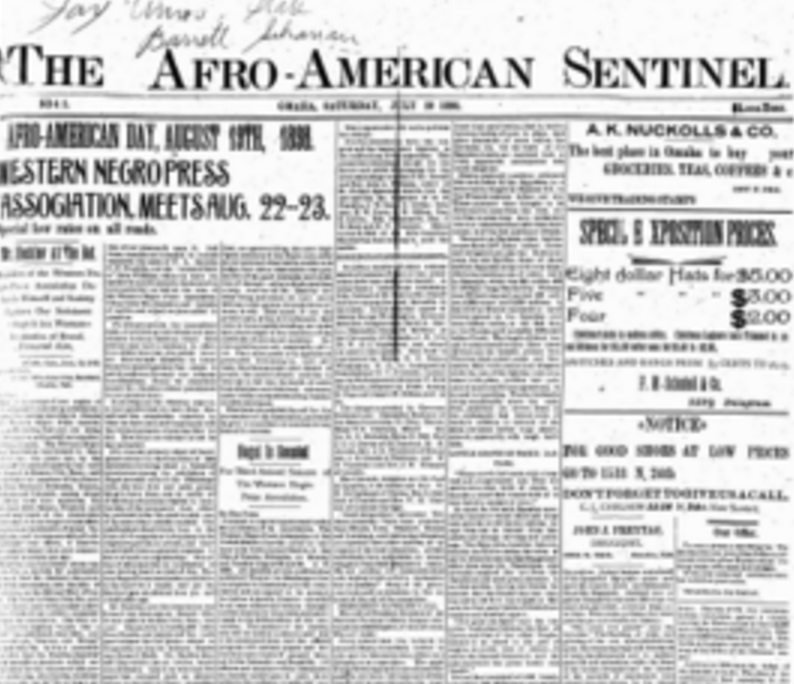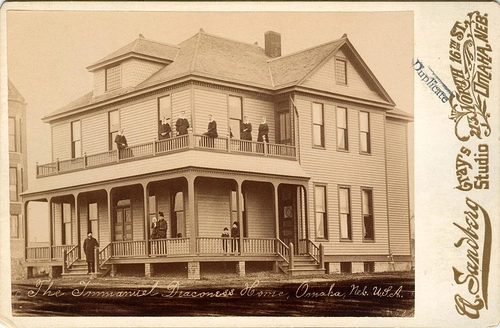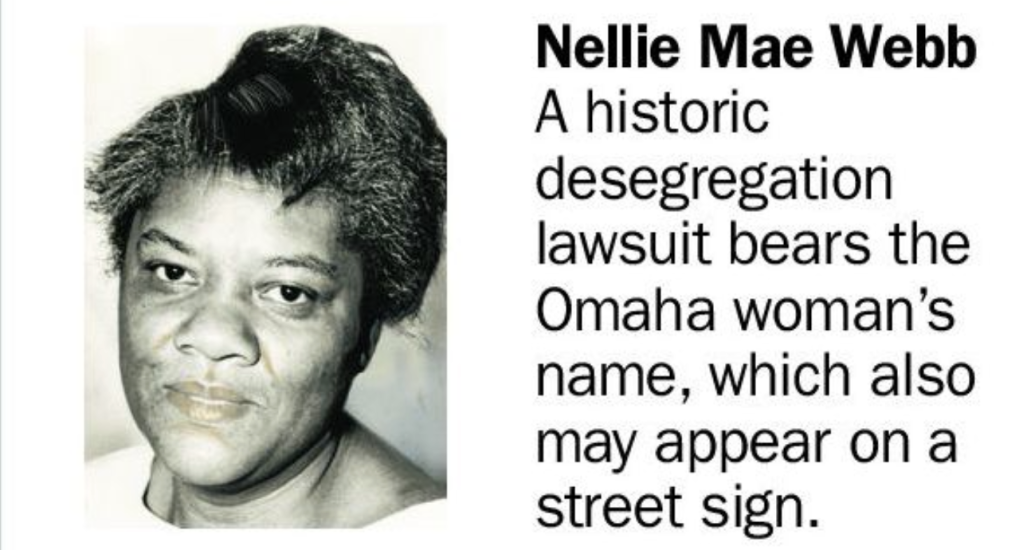North Omaha’s African American culture has grown and changed dramatically since its founding in 1854. One of the main drivers of the culture for more than a century has been the Black media. From the time Omaha’s first Black newspaper was published in 1889 through NOISE and Shanelle Williams’ continued use of social media today to build the African American community in Omaha, Black media has continued to transform the North Omaha community and the city at large.
The first Black newspaper ever was published by John B. Russworm in 1827, and was called Freedom’s Journal. The first Black newspaper in Omaha was founded by Ferdinand Barnett and was called The Progress. In the 125-plus years since, the primary champions of Omaha’s African American community have been Black newspapers, working closely in hand with Black churches. The legacy of these papers lives on today.
There have been at least 10 Black newspapers in Omaha history:
- The Colored Advocate, 1886
- The Progress, 1889-1906
- The Afro-American Sentinel, 1892-1925
- The Enterprise, 1893-1920
- The Monitor, 1915-1929
- The New Era, 1921-1926
- The Omaha Whip, 1922
- The Omaha Advocate, 1923-1925
- The Omaha Guide, 1926-1958
- Omaha Chronicle, 1933-1938
- Omaha Journal, 1934-1936
- The American Record, 1945-1948
- The Omaha Star, 1938-present
- Metro Star Times, 1990-1991
Details about several of these newspapers follows.
1. The Colored Advocate (1886-)
John Claus Hubbard (1852-1907) started the first Black newspaper in Omaha in 1886, called the Colored Advocate. Founded to “represent the colored people of Omaha,” it was reputed to give “some sound and manly political advice to its patrons, which they will do well to heed.” In July 1886, the Omaha Bee wrote, “The Advocate shows considerable editorial ability and should find a permanent place in Nebraska journalism.” No copies are known to exist.
2. The Progress (1889-1906)

In 1889, The Progress became the second African American newspaper in Omaha. It was established by Ferdinand Barnett, born in 1854, who was journalist, civil rights activist, politician, and government employee. He published The Progress from 1889 to 1906 before being appointed by the Douglas County Court deputy clerk.
A staunch Democrat, in 1926, Barnett was elected to the Nebraska State House of Representatives. His support for the Democratic Party frequently put him at odds against competing newspapers, despite his brother, Alfred Barnett, writing for the paper until 1906. Born in 1854, Barnett died in 1932.
3. Afro-American Sentinel (1892-1899)

In 1892, Cyrus D. Bell started a newspaper called The Afro-American Sentinel. Born in Mississippi as a slave on a cotton plantation, Bell arrived in Omaha in 1868. The Sentinel was pro-Democrat and pulled for Grover Cleveland at a time when almost all Blacks supported the anti-racist Republican party, which was the party of Abraham Lincoln.
In the Sentinel, Bell responded to Booker T. Washington’s 1895 “Atlanta Compromise Speech” in an unexpected way. He openly wrote that higher education for Blacks should be limited, saying that “the race is in too big a hurry,” and that there were not yet jobs for college-educated Black people. Ultimately, he suggested that education was disruptive to society. His position as a radical conservative pitted him against competing papers that supported the Republicans.
Bell folded the newspaper in 1899 after his wife died. He stayed involved in Omaha politics and died in 1925.
4. The Enterprise (1893-1920)

The leading Black newspaper in Omaha during the 1890s and 1900s was easily The Enterprise. In 1893, George F. Franklin started publishing The Enterprise, later relinquishing leadership to Thomas P. Mahammitt and the editorship of his wife, Ella Mahammitt. Lasting for 27 years, it was the longest lived of any of the early African-American newspapers published in Omaha.
Rev. John Albert Williams wrote frequently for the paper before founding his own paper. The Enterprise’s other reporters and writers included Ella L. Mahammitt, who was his wife; Josephine Sloan Yates, Comfort Baker, Victoria Earle Matthews, and Margaret James Murray, who was the wife of Booker T. Washington.
During its early years, the fame of the paper allowed Mahammitt to sit on the executive committee of the Western Negro Press Association and later, the National Afro-American Press Association in 1905.
Mahammitt and The Enterprise frequently advocated civil rights and black empowerment. In 1906, Mahammitt was involved in a struggle with a city council candidate who wanted to promote redlining in the city. In 1907, The Enterprise advocated for a boycott against businesses refusing to serve Blacks. The paper closed by 1920. Mahammitt died in 1950.
Read my article about The Enterprise.
5. The New Era (1921-1926)

In 1921, Harrison Pinkett hired George Wells Parker to be editor of a new Omaha newspaper called The New Era. Paying out of pocket for its publication, Pinkett and Parker had a falling out soon after the paper launched. However, the paper continued under the editorship of Count Wilkinson. It closed in 1926.
6. The Omaha Whip (1922)

In 1922, George Wells Parker created a new Black newspaper in Omaha called The Omaha Whip. It ran for only two editions before folding. In it, Parker accused Pinkett, Ole Jackson and Johnny Moore of promising the black vote to police superintendent Dean Ringer. Parker also accused Pinkett supporting the Ku-Klux-Klan.
Read my article about The Omaha Whip.
7. The Monitor (1915-1929)

The best known and most widely read of all African-American newspapers in the city was the Omaha Monitor, established in 1915, edited and published by Reverend John Albert Williams. It stopped publishing in 1929.
Before starting his paper, Rev. Williams regularly penned letters to the editor of Omaha’s main newspapers, including the Omaha World-Herald and the Omaha Bee. After writing for The Enterprise, Williams knew he wanted to start his own paper. In 1915, he did just that by launching The Monitor.
Starting as a church paper, Williams branched out to cover the general public. From the beginning, Williams began taking strong positions on the important issues of the day. It was Williams who originally claimed The Bee and another Omaha paper, The Daily News, fanned the flames of racism that led to the 1919 lynching of Will Brown and the Courthouse Riots through their “biased treatment of [B]lacks.”
George Wells Parker and Lucille Skaggs Edwards both worked for the paper. Edwards began her writing career in 1906 as the first black woman to publish a magazine in Nebraska, which was called The Women’s Aurora. Parker founded the Hamitic League of the World in 1917, eventually leaving The Monitor because of political differences.
The paper ceased publishing in 1929.
8. Omaha Guide (1927-1958)
The New Era shut down in 1926. That year, Herman J. Ford, Charles C. Galloway and B. V. Galloway launched The Omaha Guide. With a circulation of 25,000, the paper covered local and state politics along with North Omaha’s cultural life. Their “Illustrated Feature Section” was innovative, and provided a number of important series for Omaha’s Black community. The marketing and sales department succeeded in developing an advertisers’ list with businesses from coast to coast. During the 1930s, The Guide was the largest African-American newspaper west of the Missouri River. S. Edward Gilbert (1903-1976) and Mildred Gilbert-Brown (1905-1989) ran the advertising department there, and left the paper in 1938 to start the Omaha Star. It ran from 1927 to 1958, the year Charles Galloway died.
Read my article about the Omaha Guide.
9. Omaha Chronicle (1933-1938)
John B. Horton, Jr. worked at the Omaha Guide before he founded a Black newspaper called the Omaha Chronicle in 1933. The Chronicle was only published for one year. There was also a separate unrelated newspaper in Omaha called The Chronicle in the 1880s. A member of the Douglas County Central Republican committee, Horton was appointed to the Republican National Committee in 1936. His newspaper folded in 1938, and he moved to Kentucky to become one of the most important African Americans in the United States’ advertising industry.
10. The American Record (1945-1948)

William and Dorothy Glenn published the American Record newspaper from 1945 to 1948 in Plattsmouth, relying on their circulation in Omaha to stay afloat. Apparently, it didn’t work and those clearly in merely three years.
11. The Omaha Star (1938-present)

Today, African-American culture in Omaha is regarded as being anchored by The Omaha Star. Founded by the late Mildred D. Brown and her husband S. E. Gilbert in 1938, the original circulation was around 5,000. The salesperson for The Guide, Brown led her paper to success with advertisers too, all while writing and editing positive, powerful news about North Omaha and African Americans in Omaha. Brown is believed to be the first female to have founded a newspaper in Nebraska, and is almost definitely the first African-American woman to have founded a newspaper. She managed the paper for the rest of her life, and in 1945 The Star became the only one representing Omaha’s Black community.A bunch of notable reporters and salespeople worked for The Omaha Star.
Jazz great Preston Love, modern day media mogul Cathy Hughes, and important Omaha journalist Charles B. Washington were among the greatest. In addition to being the first African American woman in the United States to launch a newspaper, she was also the first African American woman inducted in the Omaha Business Hall of Fame, and was appointed a Goodwill Ambassador to East Germany by President L.B. Johnson. Brown passed away in 1989.
In 2016, the newspaper has a circulation of more than 30,000 and is distributed to 48 states. After being run by Mildred Brown’s niece Marguerita Washington for more than two decades, today the paper is managed by editor Terry Saunders.
Read my article about The Omaha Star.
Struggles

From my shallow but ongoing studies of Black newspapers in Omaha, I have learned that there’s rarely been smooth sailing for these bastions of the community. An ex-slave, a determined minister and a powerful saleswoman built and rebuilt the backbone of the printed word in North Omaha, and it wasn’t easy.
One of the greatest struggles happened almost at the beginning of the industry in the city.
The first Black newspaper in Omaha was called The Afro-American Sentinel, and was launched in 1892. Its first competitor, The Progress, appeared in 1889. The second competitor at the time was The Enterprise, which was founded in 1893.
Two years after The Enterprise was founded, the dominant leader among African Americans, Booker T. Washington, gave a speech called the Atlanta Compromise. In the controversial speech, Washington proposed that Southern Blacks would work how white people wanted them to and give in to all white political rule, while Southern whites guaranteed that blacks would receive basic education and due process of law. This shown the light brightly on the difference between the papers, and because of that, the truth was seen by Omaha’s African American community:
- The Afro-American Sentinel was pro-Democrat and strongly endorsed Booker T. Washington’s position
- The Enterprise supported Washington making a compromise
- The Progress was pro-Republican and entirely against Washington’s proposition and any compromise of any kind
The African American community in Omaha was reportedly split in its support, too.
It was hard for the three papers to all survive in Omaha. The original publisher of The Enterprise left Omaha in 1898, and that paper outlived the other two. In 1896, it was called by The National Protest the “best colored paper published in Omaha.” Its journalists went on to continue the editorial legacy of the paper, too.
Economics often bit at the heels of Omaha’s Black newspapers. Trying to balance between truth-telling and appealing to white advertisers, it appears that the papers often reduced the role of their editorializing and journalism in the face of economic pressure.
If that weren’t enough, there were a lot of political allegations from Omaha’s white population, too. During the 1920s, both The Monitor and the New Era were labelled Communist because of their reporting. Starting in the 1940s, J. Edgar Hoover’s FBI started keeping a file on Mildred Brown and her Omaha Star. When it was recovered by a FOIA request in the 2000s, it was found to have 1,400 pages of surveillance data, including many inaccurate descriptions of Brown’s time and energy. The file included data collected by the FBI’s illegal activities through the 1970s era COINTELPRO program.
Present
Today, in spite of encroaching social media and other sources available to African Americans in Omaha, the Omaha Star continues its run. I subscribe to stay in touch with ongoing developments in the community, and regularly find useful news, insightful commentary and other contents that are important to my understanding of modern day North Omaha, as well as the history of the community. I would suggest anyone interested in the same to subscribe immediately.
However, I’d also suggest that we all plug into the news and conversations that breath life into North Omaha in any way possible. Whether happening online, in person or otherwise, it is VITAL that Black news continues to reach Omaha’s African American community, no matter where it is!
People in Omaha’s Black Newspapers
There have been a lot of individuals who have driven Omaha’s Black newspaper industry. Here are some of them.
- Ferdinand Barnett (1854 – 1932) Publisher, Omaha Progress
- Alfred Barnett (1858 – 1905[?]) Journalist, Omaha Progress
- Cyrus Bell (1848 – 1925) Publisher, The Afro-American Sentinel
- George F. Franklin (1852 – 1901) Publisher, The Enterprise
- Thomas P. Mahammitt (1862 – 1950) Publisher, The Enterprise
- Ella Mahammitt (1863 – c1903) Journalist, The Enterprise
- Sarah Mahammitt (c.1873 – 1956) Journalist, The Enterprise
- Rev. Dr. John Albert Williams (1866 – 1933) Publisher, The Enterprise
- Comfort Baker (1869 – ?) Journalist, The Enterprise
- Victoria Earle Matthews (1861 – 1907) Journalist, The Enterprise
- Margaret James Murray (1865 – 1925) Journalist, The Enterprise
- George Wells Parker (1882 – 1931) Journalist, The Enterprise; Publisher, The New Era
- Lucille Skaggs Edwards (1875 – ?) Publisher, The Women’s Aurora
- John B. Horton, Jr. ( ) Publisher, Omaha Chronicle
- Herman J. Ford (? – ?) Publisher, Omaha Guide
- C. C. Galloway (? – ?) Publisher, Omaha Guide
- B. V. Galloway (? – ?) Publisher, Omaha Guide
- Dr. Shirley Edward Gilbert (1903-1976)) Publisher, The Omaha Star
- Mildred Brown (1905 – 1989) Publisher, The Omaha Star
- Preston Love, Sr. (1921–2004) Journalist, The Omaha Star
- Charles Washington (1923–1986) Journalist, The Omaha Star
Timeline of Black Newspapers in Omaha
- 1892—Cyrus Bell launches the first Black newspaper in Omaha called The Afro-American Sentinel
- 1893—George F. Franklin launches The Enterprise
- 1895—Booker T. Washington gives his “Atlanta Compromise Speech,” and different responses in Omaha’s Black newspapers become stark and obvious
- 1898—Thomas P. Mahammitt takes control of The Enterprise
- 1898—Mahammitt sits on the executive committee of the Western Negro Press Association
- 1905—Mahammit sits on the executive committee of the National Afro-American Press Association
- 1906—Lucille Skaggs Edwards is the first black woman to publish a magazine in Nebraska, called The Women’s Aurora
- 1915—Reverend John Albert Williams launches The Monitor
- 1917—George Wells Parker launches a national magazine called The Crusader in Omaha
- 1920—The Enterprise ends
- 1921—Harrison Pinkett launches The New Era
- 1922—Count Wilkinson takes control of The New Era
- 1922—George Wells Parker launches The Omaha Whip and it ends
- 1925—The Afro-American Sentinel ends
- 1926—The New Era ends
- 1926—Herman J. Ford, C. C. Galloway and B. V. Galloway launch The Omaha Guide
- 1929—The Monitor ends
- 1938—Mildred D. Brown and her husband S. E. Gilbert launch The Omaha Star
- 1958—The Omaha Guide ends
- 1989—Dr. Margarite Washington takes control of The Omaha Star
- 2020—The Omaha Star continues
You Might Like…
MY ARTICLES ON AFRICAN AMERICAN NEWSPAPERS IN OMAHA
Newspapers: The Enterprise | Omaha Star | Omaha Guide | The Omaha Whip |
People: Ferdinand Barnett | Cyrus D. Bell | Rev. Dr. John Albert Williams | Comfort Baker | George Wells Parker | C. C. Galloway | Mildred Brown
MY ARTICLES ABOUT SEGREGATION IN OMAHA:
Omaha Black-Owned Businesses | Segregated Schools | Segregated Hospitals | Segregated Hotels | Segregated Churches | Segregated Newspapers | Segregated Baseball
- A History of African American Politics in Omaha
- A Timeline of Race and Racism in Omaha
- A Biography of Mildred Brown by Jody Lovallo
- A Biography of Dr. Marguerita Washington
Elsewhere Online
- Official Omaha Star online archives
- Douglas County Historical Society The Monitor archives
- Leo Adam Biga (2016) “Play considers North Omaha history through the eyes of Mildred Bown“
- “African-American Newspapers in Omaha” by the Invisible History Project of Omaha Public Schools.
Nebraska State Historical Society Collections available:
- Enterprise: 1895-1897; 1908-1911
- New Era: 1922-1926
- Omaha Guide: 1926-1958
- Omaha Monitor: 1915-1929
- Omaha Star: 1938-present
- Progress: 1890-1891
- Mildred Brown papers
Sources
- Amy Helene Forss (2014) Black Print with a White Carnation: Mildred Brown and the Omaha Star Newspaper, 1938-1989. U of Nebraska Press.
- Richard M. Breaux “The New Negro Renaissance in Omaha and Lincoln, 1910-1940” in Cary D Wintz and Bruce A. Glasrud (2012) The Harlem Renaissance in the American West: The New Negro’s Western Experience. Routledge.
This video shows Dr. M. Washington speaking with students from the Invisible Histories Project with Omaha Public Schools about the history of the Black press in North Omaha.






Leave a comment